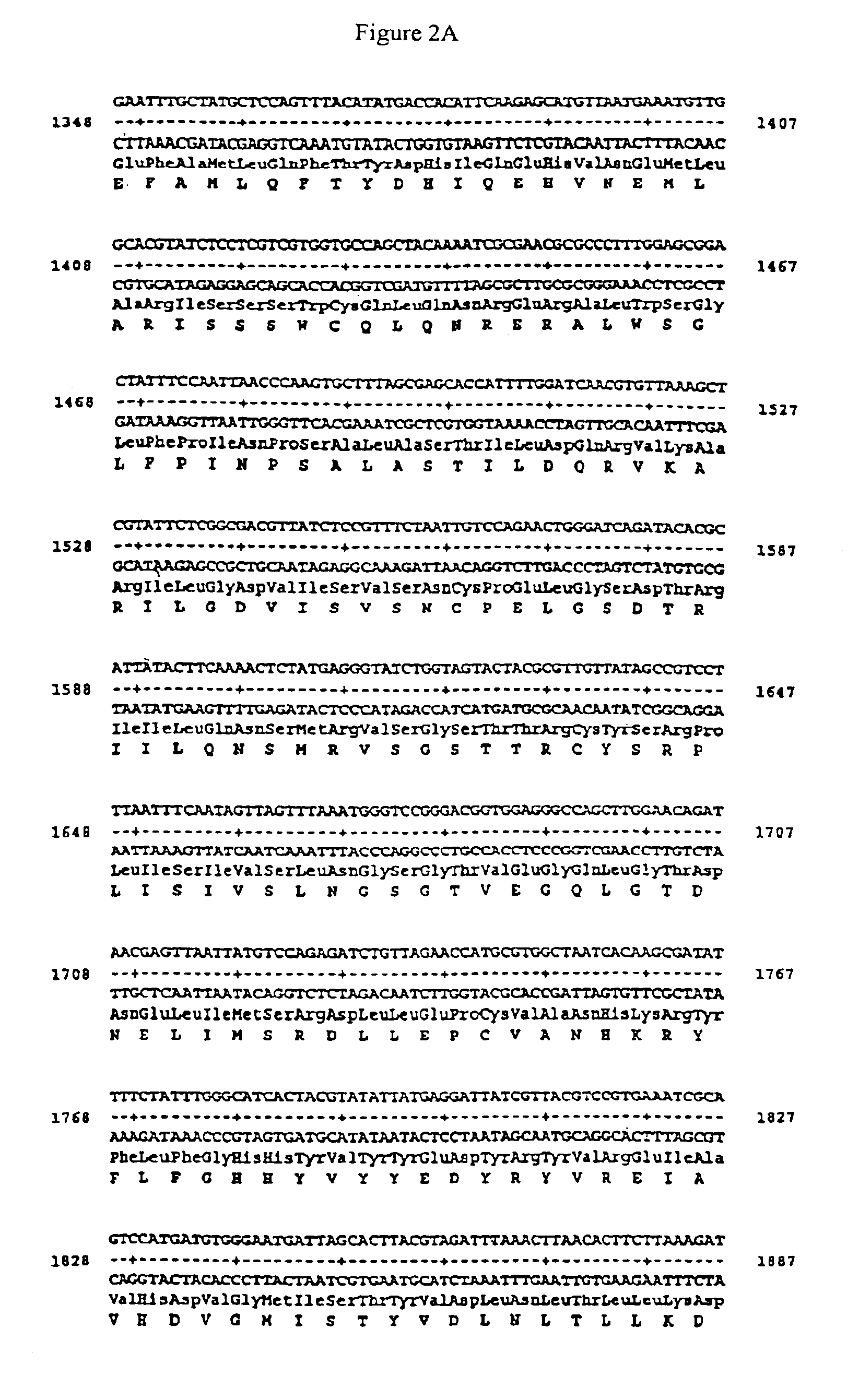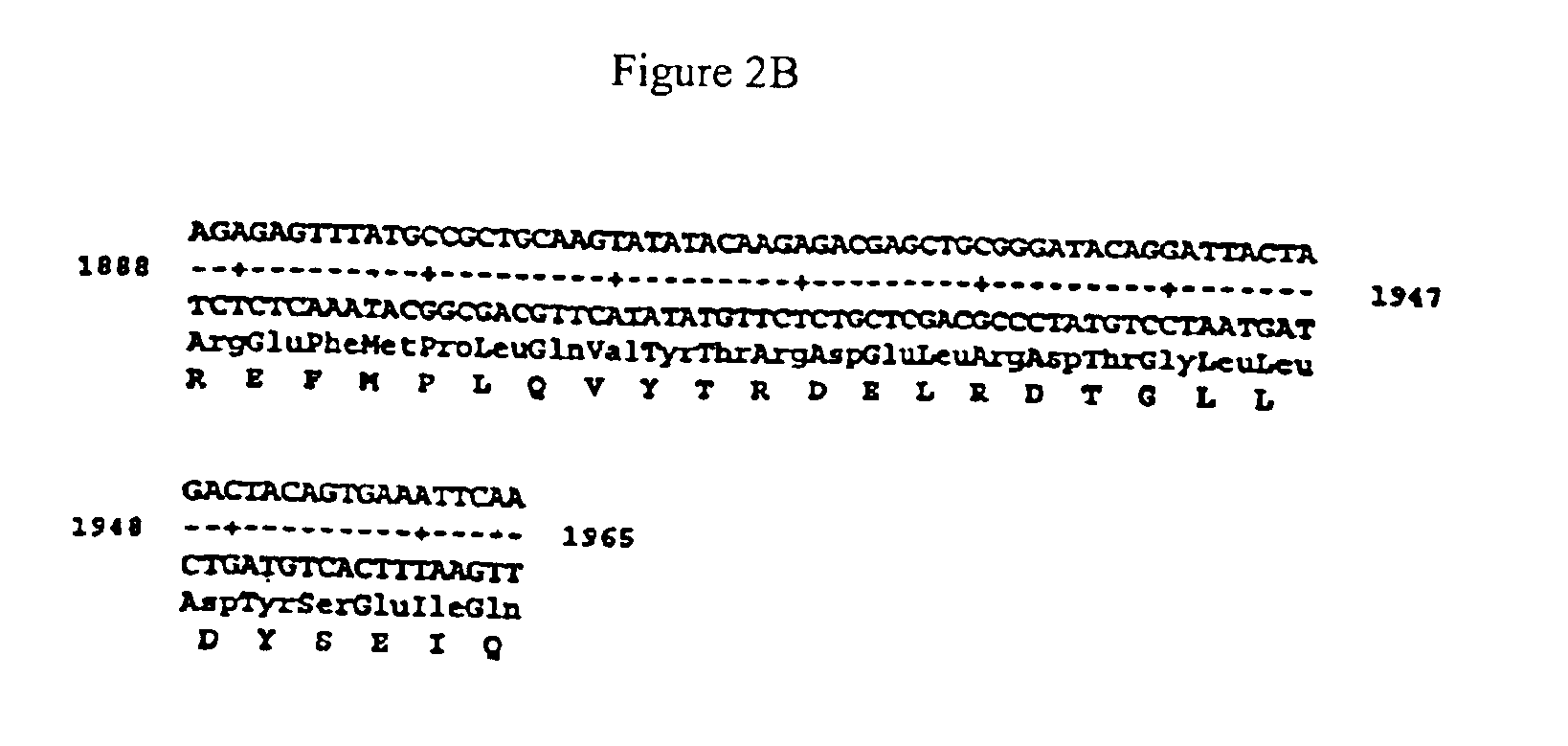Immunoreactive regions of glycoprotein gpII of varicella zoster virus (VZV)
a glycoprotein and varicella zoster virus technology, applied in the field of immunomodulatory peptides, can solve the problems of insufficient preparation of glycoprotein gpii, severe symptoms, and inability to protect maternal antibodies, etc., and achieve the effect of preventing the formation of antibodies
- Summary
- Abstract
- Description
- Claims
- Application Information
AI Technical Summary
Benefits of technology
Problems solved by technology
Method used
Image
Examples
example 1
Isolation of Viral VZV Virions and DNA Extraction
[0034]Virions were released from VZV-infected fibroblasts by means of ultrasonication. The viruses were purified from cellular constituents by passing through a linear sucrose gradient (20-70% (w / v)) Following incubation with DNase I, viral DNA was released from virions by treating with proteinase K and sodium dodecyl sulfate (SDS). After extraction with phenol / chloroform, viral DNA was precipitated with ethanol.
example 2
Cloning ORF31 and Subcloning the Immunoreactive Fragment
[0035]The viral DNA (see Example 1) was used as the template for amplifying ORF31, which encodes gpII. The following primers were used as amplification oligonucleotides:
[0036]
gpIIH 5′ GGAATTCCTTCTATGTTTGTTACGGCGGTTG 3′;gpIIR 5′ GCTCTAGAGCATTTACACCCCCGTTACATTCTCG 3′.
While these oligonucleotides are complementary to the corresponding segment of the published sequence (A. J. Davison & J. E. Scott. (1986), J. Gen. Virol. 67, 1759-1816), they contain, at their 5′ termini, a restriction cleavage site sequence which does not hybridize with the template DNA. After amplification had taken place, the amplificate, of 2630 bp in size, was cleaved at the terminus with restriction enzymes EcoRI and XbaI and ligated into the expression vector pMAL-p2 which had previously been linearized with EcoRI and XbaI (pMALp-2-ORF31). The entire ORF31 was sequenced in an overlapping, bidirectional manner. It possessed a base substitution of cytosine by t...
example 3
Subcloning the Immunoreactive Epitope
[0038]By carrying out amplifications using vector pMAL-gpII* as the template DNA and the oligonucleotides:
[0039]
5′CGGGATCCCGTGTTAAAGCTCGTATTCTCGGCGACG3′ and5′CCCAAGCTTTAATCCTGTATCCCGCAGCTCGTCTCT3′;5′CGGGATCCGTTTCTAATTGTCCAGAACTGGGATCAG3′ and5′CCCAAGCTTATACGTAGTGATGCCCAAATAGAAAA3′ or5′CGGGATCCTCTATGAGGGTATCTGGTAGTACTACGCGTT3′ and5′CCCAAGCTTAGCCACGCATGGTTCTAACAGATC3′
it was possible to obtain a 427 bp fragment, a 240 bp fragment or a 149 bp fragment, each of which was subcloned, after having been subjected to restriction digestion with the enzymes BamHI and HindIII, into vector pMAL-c2 which had been linearized with BamHI and HindIII. The resulting constructs were designated pMAL-427-gpII, pMAL-240-gpII and pMAL-149-gpII, respectively.
PUM
| Property | Measurement | Unit |
|---|---|---|
| Density | aaaaa | aaaaa |
| Density | aaaaa | aaaaa |
Abstract
Description
Claims
Application Information
 Login to View More
Login to View More - R&D
- Intellectual Property
- Life Sciences
- Materials
- Tech Scout
- Unparalleled Data Quality
- Higher Quality Content
- 60% Fewer Hallucinations
Browse by: Latest US Patents, China's latest patents, Technical Efficacy Thesaurus, Application Domain, Technology Topic, Popular Technical Reports.
© 2025 PatSnap. All rights reserved.Legal|Privacy policy|Modern Slavery Act Transparency Statement|Sitemap|About US| Contact US: help@patsnap.com



